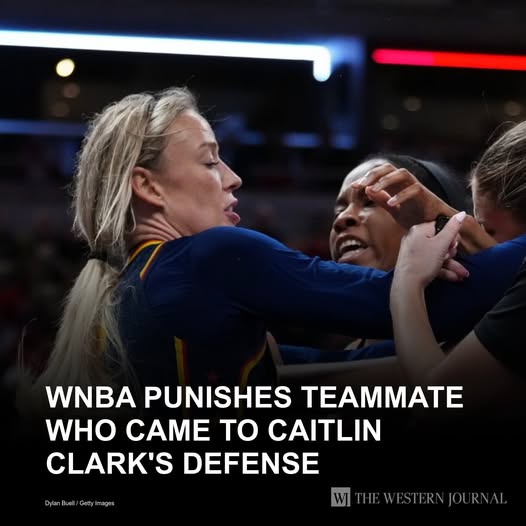Chaos erupted in Connecticut and quickly sent shockwaves throughout the WNBA community, as Phoenix Mercury guard Sophie Cunningham and Chicago Sky guard Marina Mabrey were both fined following a heated altercation that unfolded after each was assessed a Flagrant 2 foul during a recent contest. The physical clash—equal parts dramatic and unsettling—highlighted a game that spiraled out of control and ended with more controversy than competition. What began as a highly anticipated matchup turned into a chaotic brawl that forced league officials to act swiftly and decisively, issuing financial penalties and reigniting broader conversations about sportsmanship, accountability, and the emotional temperature of the modern WNBA.
The incident occurred in the second half of a tightly contested game between the Phoenix Mercury and the Chicago Sky, hosted at Mohegan Sun Arena. With playoff positioning and pride on the line, both teams entered the contest playing with the kind of edge expected in the latter stages of the WNBA season. But that edge turned sharp when a hard foul by Cunningham on Mabrey resulted in immediate tension. Moments later, Mabrey responded with an equally aggressive move, leading to a melee that briefly halted the game and forced referees and coaching staff from both sides to intervene. The referees reviewed both plays and ultimately assessed Flagrant 2 fouls to each player—an automatic ejection under league rules.
As the dust settled, WNBA Commissioner Cathy Engelbert announced that both Cunningham and Mabrey would be fined an undisclosed amount for their conduct, though neither would face additional suspensions. The league’s decision underscored a zero-tolerance approach to on-court violence while attempting to maintain balance in a season already brimming with intensity and emotion.
Witnesses inside the arena described the scene as electric—and then unsettling. What started with Cunningham delivering a hard screen that sent Mabrey crashing to the floor quickly escalated. Mabrey, visibly frustrated, got up and approached Cunningham. Words were exchanged, emotions ran high, and within seconds, the two guards were tangled up in a confrontation that had players on both teams rushing toward the commotion. The crowd gasped as security staff and officials worked to separate the athletes, ultimately leading to a delay of several minutes before order was restored.
The league’s disciplinary action was seen by some as a fair measure, while others felt the penalties didn’t go far enough. Fans and analysts took to social media with divided opinions. Some praised the WNBA for not overreacting to a scuffle that, while heated, didn’t result in injuries or continued fighting. Others argued that both Cunningham and Mabrey crossed the line and should have been suspended to send a stronger message about player conduct and sportsmanship.
Cunningham, known for her tenacity and physical style of play, later issued a brief statement through the Mercury’s public relations team, expressing remorse but defending her actions as “part of the game.” She acknowledged that emotions got the better of her but insisted she never intended to hurt anyone. “I’m passionate about competing,” Cunningham said. “It was a hard foul, and I regret how things escalated. But I’m always going to stand up for myself and my team.”
Mabrey, meanwhile, posted to her social media platform shortly after the game, offering a more cryptic response. “Protecting my space. Always,” she wrote, followed by a flexing emoji and the words “#SkyTown.” It was a message interpreted by many as a defiant refusal to apologize, but also as a player taking pride in her grit and intensity.
While the incident only lasted a few moments in real time, its ripple effect has lasted far longer. It’s not the first time emotions have boiled over in the WNBA this season, but it may be the most visible and widely discussed example so far. With increased attention on the league thanks to a surge in television viewership, rising stars, and endorsement deals, the Cunningham-Mabrey confrontation served as a flashpoint in the evolving identity of professional women’s basketball. Are these athletes competitors first and entertainers second? Or does the WNBA now face a growing challenge in policing the kind of behavior that, while common in men’s sports, is still scrutinized more harshly in the women’s game?
Some fans see the incident as a symptom of progress. After all, physical confrontations have long been a hallmark of intense competition in the NBA and other major sports leagues. That it happened in the WNBA and garnered such passionate discussion could be seen as a sign that the league is now on par in terms of stakes, investment, and emotional gravity.
But others are concerned about the optics. Former WNBA greats weighed in, including Lisa Leslie and Candace Parker, both of whom called for players to “channel their competitiveness the right way.” Parker, currently serving as an analyst, remarked during a halftime broadcast the following night, “You can play hard. You can talk trash. But you’ve got to draw a line. Flagrant 2s and scuffles take away from the game we’re trying to grow.”
League insiders also noted that the timing of the incident couldn’t have been worse. With multiple primetime broadcasts and national media covering the WNBA like never before, moments like these get magnified. ESPN cameras captured the entire confrontation in high definition, and clips of the altercation quickly circulated across social media, racking up millions of views. For the league office, the challenge was not only assessing the right penalties but doing so in a way that maintained the WNBA’s image while not neutering the competitive spirit that fans and players alike cherish.
Head coaches from both sides offered pointed remarks. Mercury head coach Nate Tibbetts defended Cunningham’s intensity but admitted the team needed to better manage in-game emotions. “We love how Sophie competes,” he said. “But we also know there’s a fine line between toughness and trouble. We’ll address it internally and move forward.” On the other side, Sky head coach Teresa Weatherspoon showed visible frustration in her postgame press conference, calling the altercation “unacceptable” and emphasizing that her team must “represent Chicago with pride, not pettiness.”
Perhaps more than anything, the Cunningham-Mabrey altercation exposed the pressures bubbling under the surface of a league in transformation. With more at stake financially, culturally, and professionally than ever before, players are walking a tightrope between passion and control. It’s a balancing act that reflects the growing pains of a sport stepping into the mainstream spotlight.
For younger fans and aspiring hoopers, the brawl was a reminder that elite athletes are still human—flawed, emotional, and occasionally combustible. For league executives, it was a lesson in how quickly a season narrative can change. And for Cunningham and Mabrey, it was a costly moment of conflict that will likely follow them for the rest of their careers.
Still, both players are expected to return to action in their teams’ next games, and league insiders say neither will be under any kind of probationary status. That doesn’t mean the matter is behind them. Opponents may test their limits. Fans will undoubtedly keep a closer eye. And with both teams still in playoff contention, there’s a very real possibility that Phoenix and Chicago could meet again down the road—with even higher stakes.
For now, the WNBA hopes the fines will serve as a deterrent. The message is clear: the league will protect its image, its players, and the integrity of the sport. But behind closed doors, the tension lingers. These are competitors who aren’t afraid to push boundaries—and sometimes, they push too far. The chaos in Connecticut may be over, but the story it tells about where the league is headed—and the fire burning in its players—has only just begun.



